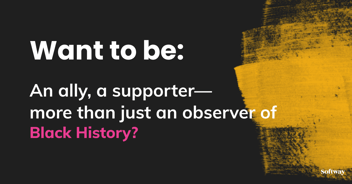
The current state of affairs in the U.S. has brought attention to the killing, mistreatment, and mischaracterization of Black Americans in society. Normally, diversity and inclusion (D&I) advocates would consider it a win to have so many leaders of all backgrounds leaning in to a critical and overdue conversation around the issues plaguing Black people. However, many business leaders are commenting on racial issues happening in the world while failing to deal with the very real problems happening within their own companies.
Many leaders like to believe that having diversity and inclusion initiatives, teams, and goals equals progress and success in the space. But, as we’re learning with the protests and global response to the recent spate of killings of unarmed Black Americans, talk is cheap. If you really want to know how your organization works for underrepresented Black employees, explore the suggestions below without the need to defend, deflect, or reason away any evidence of injustice. Here are nine questions to ask yourself and your team to help you start identifying constructs, biases, and policies that contribute to the mistreatment and mischaracterization of Black employees in your organization.
1. How are Black employees represented in your senior leadership team and board of directors?
It’s almost comedic when organizations publicly communicate their commitment to diversity but have zero diverse representation in key places of power and influence. Valuing gender diversity is not enough or equitable. From the standpoint of Black employees, listening to well-worded rhetoric from your comms team during company celebrations or in press releases that promote the value of diversity is particularly frustrating when promotion decisions and other management actions show otherwise. Besides taking note and taking action regarding the diversity of your top leadership, do a review of the rest of your organization’s hierarchy structure to see if there are specific actions, managers, or structures in place that could be blocking a pipeline of diverse leaders.
2. Are you empowering your D&I teams to be effective?
The work of a D&I team is essential to helping overcome challenges for Black employees and other marginalized groups within a company. In many organizations, this team is (and should be) staffed by a highly diverse group of employees.
If there is a lack of diversity within your company’s leadership, even D&I teams that reflect broad and necessary diversity may only get so far in convincing leaders to prioritize the challenges they may not see, understand, or appreciate. So while it’s an important task to hire and build a D&I team that reflects the organization you’d like to have, their efficacy may reach a limit simply if leadership teams don’t mirror the same makeup or lack the empathy to enact change.
3. Is the highest concentration of Black employees in support and junior roles?
I encourage you to look cross-sectionally at your business. Dive deep into who is staffing your support functions, HR and IT positions, procurement, facilities, and assistant roles. These are generally the main departments that house Black employees in a company. Furthermore, you will likely find large concentrations of Black employees within the lower tier of the organizational structure, and less so in revenue-making or decision-owning roles. This concentration likely thins out as you move higher and closer to strategy roles.
One big reason this distribution matters is that when cost containment decisions are made, support and junior roles are also the ones that are most impacted during layoffs, furloughs, and benefits cuts. This means that Black employees are disproportionately affected in economic downturns by default. Now is a great time to align your outward commitments to diversity with your internal operations by taking stock of this distribution within your organization and then promoting or hiring Black employees into higher roles.
Simply recruiting college graduates is not enough. The retention rate of Black employees is often lower than white employees across many organizations. One reason for this may be the promotional velocity of minorities in businesses compared to their non-minority peers. Upward mobility is a struggle for many Black employees, and attrition rates for Black employees should be in your regular conversations around people issues as a leader.
4. Does your brand imagery reinforce the notion that Black employees only play support roles?
Check out your recruiting and marketing content and your company website and social media accounts. Across many organizations, you will see a noticeable trend. Black people are often present in the public-facing imagery. However, they are often also seen receiving instructions from white men and women, or wearing uniforms that distinguish them as manual laborers. We can blame this on the stock photography available or a lack of a creative budget, but it still sends a message that Black employees are not seen as leaders in their businesses.
5. Is Family and Medical Leave Act (FMLA) time taken disproportionately by your Black employees?
Real talk: FMLA leaves — unpaid, job-protected leaves taken for medical or family reasons — can sometimes be used by Black employees to take a break from the emotional and mental stresses caused by white peers and superiors (largely in the form of bias and microaggressions). I personally have Black women in my circle who have used FMLA leaves as a stopgap. While they may have a legitimate reason to care for a family member, it’s a tacit understanding among Black employees that FMLA is for protection. It temporarily removes you from toxic environments where your struggle is yours alone, not understood or prioritized by their manager or other higher-ranking workers. As a leader, your data may reveal a trend among your marginalized employees who leverage FMLA leaves more than any other group in your organization. Where there’s smoke, there’s fire — check on those employees and ask about how they’re being treated by their managers and their peers. Review their managers’ past evaluations or ask for their direct reports to do new evaluations. Consider giving Black employees taking FMLA leaves more paid time off.
6. Are there troubling feedback trends in your performance management systems around Black employees?
“Not a team player.” “Attitudinal.” “Emotional.” “Poor communication skills.” “Sassy.” “Unfriendly.” “Lacks professionalism.”
These are labels often seen by Black employees in their reviews and performance evaluations. Some of these stem from the bias (known and unconscious) of their immediate manager. Most of these labels, you will find, never appear in reviews of their non-minority peers. If your performance management system is electronic, you can parse through common language in recorded feedback applied to different marginalized groups to paint a clear picture of the types of conversations happening between supervisors and staff.
In D&I, we call these types of labels “dog whistles” because employees of color are the only ones who see and feel the impact. When Black employees try to bring it up, no one else sees, feels, or validates said impact. We are left unprotected, undervalued, and unheard by our leaders. Task your HR team with developing a word cloud of feedback based on marginalized groups. You might save a career because of it.
7. Is supplier diversity an afterthought?
You might say that you have a strong diversity supplier program, complete with awards and banquets. However, your data may highlight that your spend level with diverse suppliers pales in comparison with their white counterparts. Also look at the type of projects or initiatives you have with diverse suppliers. You may be willing to buy toilet tissue and menial supplies from minority-owned businesses, but are you seeking legal, financial, or strategic advice from them? On the marketing side, companies typically engage cultural agencies to seek the dollars of those communities, but those agencies and firms are rarely considered for marketing scopes beyond that, even if their capabilities and work quality suggest otherwise. What does procurement data suggest about where your dollars are spent?
8. Does your leadership development and training focus more on strategy, processes, and tools instead of people?
Self-assessments. Case studies. Tools for time management. Ninety-day action plans. Leadership development tends to focus more on everything but the people who are being led. Recently, the trend has been to add a 90-minute session on unconscious bias to check the D&I box off, but time and space is not provided for leaders to fully understand themselves, their teams, and differences therein. What’s worse is that performance management for leaders doesn’t align with or measure their adherence to the company’s values and accepted behaviors for achieving results. So anything goes as long as it’s not caught or leaked. Underdeveloped (as well as untouchable) leaders contribute to hard times for Black employees in your organization. If results are what matter for you, measure your leaders by some of the data points here to truly see how your leadership team is performing. But also consider investing in your leaders to be empowered and equipped to get the most out of their people, regardless of their race.
9. Are leaders uncomfortable leading, listening, and acting on open conversations internally around disparity, exclusion, or bias in the company?
Guilt. Persecution. Lack of awareness. These are some reasons why leaders may lean out of open conversations around race, difference, or lived experiences incongruent with organizational values. The emotional and empathetic investment required to have these conversations may feel too costly for underdeveloped leaders. I’ve witnessed some organizations whose culture is best categorized as “toxic positivity” because they refuse to allow for real conversations that they feel are negative. Problems must be framed as opportunities. Bad news must be repackaged as good news. Failure is not allowed, at least not equally among the staff. “Managing up” is the default communication plan with leadership. These types of organizations hurt the chances for courageous conversations to take place. Black employees may feel discouraged to share their reality because it reads as negative or ungrateful. How does your leadership team handle difficult situations and conversations?
After you look at these areas for underrepresented Black employees in your company, you can use this set of questions to investigate all of the dimensions and intersections (gender, sexual preference, religion, and so on) of diversity within your business. You might find even more opportunities to solve underlying issues and challenges faced by the underrepresented and marginalized.
Let this be a chance to use your voice and platform to really bring about lasting change in the workplace for Black employees and other people of color. If we fix things for the most marginalized groups in our companies, we solve them for everyone. Outcomes of initiatives that focus on the marginalized have consistently been proven to benefit everyone.
While I know there is so much to say and share regarding current affairs outside your organization, your biggest platform for change is within your business as a leader. If we can change the way Black Americans are treated within the walls of our companies, it can change how they’re treated while they run, shop, drive, and sleep in our communities.
This article was originally published at Marker on Medium.




